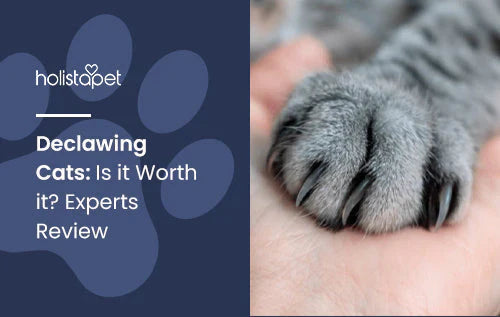You decided to get a new pet for the family, but now you might be wondering how to introduce a cat to a dog. Just like you can't force two people to like each other, you can't force two animals to do the same. You have to take it slow and let your cat and dog slowly acclimate to each other.
The good news is that most cats and dogs can learn to get along. Many factors can go into whether or not they get along - their breed, personalities, upbringing, and training - so what's the best way to ensure a peaceful transition? In this guide, we will explain how to make this process as easy as possible.
Do Cats and Dogs Get Along?
Growing up, you may have watched movies or read stories about how dogs and cats are natural enemies. However, a study in 2018 from the Journal of Veterinary Behavior reports that dogs and cats can get along just fine! One interesting point that the researchers make is that the relationship between the dog and cat was mostly dependent on the cat's amicability.
Cats are naturally more territorial animals than dogs and can show more anxiety when around other pets. Part of this may be due to the difference in size between dogs and cats. Dogs, however, are far more friendly and feel less threatened by cats!
Even if the dog and cat do not become best buds, it is still very common for them to coexist peacefully. They may not share beds or cuddle with each other, but they can live under the same roof without fighting.
One tip that many pet owners or experts will tell you is that early socialization is incredibly important. When pets are introduced to each other at a young age, they are more likely to bond. Getting your new pet used to living around other pets can play a huge role in their ability to get along.
Do Certain Cat Breeds Dislike Dogs?
Many cat breeds are easy-going and can get along with dogs just fine. However, there are a few breeds that are notorious for being mean and aggressive to other animals. They can be demanding at times and do not want to share attention.
Some of these breeds include:
Because cats tend to be more anxious and territorial than dogs, owners may want to be careful when deciding to bring any of these breeds home. Many of these cats will not hesitate to hiss or attack other animals or even humans if they feel scared or threatened at all.
Do Certain Dog Breeds Dislike Cats?
There are a few dog breeds that may not be ideal for raising a cat. Many of these breeds were originally bred to hunt small game or animals. Their natural hunting instinct may pose a danger to any smaller animal, including cats.
Some of these breeds include:
- Australian Cattle Dog
- Beagle
- Greyhound
- Schnauzers
- Siberian Husky
- Weimaraner
- Whippets
- Most Hound breeds
- Most Terrier breeds
Remember that while these breeds may not be good with cats, every dog has a different personality and may still get along with them. They should be trained and desensitized to cats from when they are a puppy. Even then, it's best to give the cat a trial period with these dog breeds under close supervision to determine if any problems will arise.
How to Introduce a Dog and Cat - Warning Signs
When first introducing a dog and a cat, pay close attention to their body language. These first signs can be an indicator of how they will get along in the future. You should monitor the first few weeks of interaction closely to avoid any issues.
Particularly for the dog or cat that is already living at home, they may feel tense when introduced to a new pet. You can calm your pet down by gently patting them and giving words of assurance. This can help them become less anxious since they trust their owners.
In recent years, many pet owners have turned to CBD products to help calm their pets. CBD has the ability to promote soothing and calming effects, and can possibly help your pet stay calm during first introductions. Check out some great new CBD products made for pets in our store.
Warning Signs From Cats
One of the main warning signs from cats is when they hiss. Cats hiss whenever they feel threatened or afraid. If they start to hiss at the dog, it may be too early to leave them alone together.
If the cat's ears are pinned back, and their tail is moving back and forth, it could be a sign that they are on the defensive while observing the dog's movement. They could be looking for a moment to strike, so keep the two at a distance.
Warning Signs From Dogs
Dogs with a strong prey drive may suddenly become very focused on the cat. They might stare intently, stiffen up, or even begin to stalk the cat. Barking or growling may be an early sign that the dog is uncomfortable with the new addition.
If your dog's ears or tail are perked up, they are on high alert. They may feel stressed or defensive when this happens. In some cases, dogs with more aggressive personalities may take sudden action.
Watch the dog closely at first, even if they don't make any initial moves. They may be waiting for you to leave the room to investigate the cat further.
How to Introduce a Cat to a Dog
The most important thing when introducing a cat to a dog is to have patience. They may not like each other right away, and some steps will need to be taken. If you are still unsure how your dog will react to a new cat, consult a trainer to ensure everyone's safety.
Proceed with Caution
When the cat or dog is first brought home, definitely pay close attention to both of their reactions. Expect initial cautious behavior from both the cat and dog. This first step of the introduction process should be kept short unless you notice positive behaviors from both.
Continue to give them face-to-face interaction for brief periods to build familiarity. Depending on how quickly they demonstrate calm behavior, you can let them roam around in the same room without restrictions.
For puppies and kittens meeting for the first time, be careful of the puppies' energy. They can be more rowdy and playful, while kittens may be more timid and careful.
Keep Them Separated at First
Even if both the cat and the dog show positive reactions towards one another, in the beginning, it is best to keep them separated at first. Attempt to keep them in separate rooms with a solid door in between. This separation keeps the dog from observing too intently.
Put up a fence to keep the dog from breaking into the room if they are too curious. Ensure your cat has everything they need in the room, including a litter box, food, water, and a bed. This separation is also so the new pet can slowly adjust to its new home and surroundings.
Feed Them on Opposite Sides of a Closed Door
In addition to separating the cat and dog initially, place their food bowls far away from each other. The goal is to gradually allow the two to get used to each other, as the dog may be overly excited in the beginning. Eventually, you want your dog to associate the smell of food (which makes them happy) with the scent of the new family member.
Swap Scents
Swapping scents is one of the best ways to get two animals accustomed to each other. You can switch their sleeping blankets or toys after a week to get them used to the smells. Another great way is to rub a towel on one animal and place it under the other's food bowl or sleeping area.
After your new cat is more settled in their home, you can even swap play areas. This switch is just another way to push the two animals to become more familiar with each other's scents. You can switch them multiple times a day but remember to put your new cat back in the sleeping spot at the end of the day.
Teach Basic Commands
Dogs are very smart animals and can learn basic commands early on. You can try to teach them simple cues such as "sit" or "stay." These commands can go a long way when introducing new members of the family to them.
Keep the training sessions short and always give positive reinforcement. Dogs learn faster and respond better when given treats or praise for successfully following a command. Cats may be harder to train since they are not motivated by rewards like dogs are.
One excellent training tip is to use the Look At That (LAT) method. You can teach your dog to look at certain objects, or in this case, the cat, and then look back at you for a treat. The goal is to keep your dog relaxed and composed, while teaching them to look at a stimulus that typically excites them, and rewarding them for looking at it calmly.
Identify Positive Body Language and Reward
During their face-to-face interactions, use basic commands to encourage calm behavior, especially for the dog. Reward the dog with treats when they sit and stay in front of the cat.
Be careful with larger dogs because even if they are in a playful mood, they could accidentally hurt the cat. Allow the cat to sniff the dog while the dog stays and continue rewarding your dog for good behavior. Don't allow the dog to fixate on the cat and ignore your calls or commands.
Crate Training
Crate training is one great way to offer more interaction without physical contact. Cats should only do crate training after some time has passed, so the cat is not startled by the dog. To start, coax your new cat into the crate and put a leash on your dog.
Allow your dog to approach the crate to sniff your cat slowly. For best results, you can do this training for a few minutes at a time, multiple times a day.
Repeat Sessions Daily
The most important thing is consistency. Repeated interactions help desensitize the animals to each other. As time goes on, you can increase the length of these sessions until they are able to be in each other's presence comfortably.
Since cats need more time to become used to their environment, it may be better to give them more freedom to explore.
Remember that this process can take anywhere from a few days to a few weeks, depending on the pets' personalities. If the pets are still not getting along after a couple of months, seek a trainer for advice.
Final Thoughts - How to Introduce a Cat to a Dog
While it is always exciting to bring home a new cat or dog, ensuring that they are amicable is just as important. Especially if children are thrown into the mix, early socialization with pets is critical, so they learn how to live with other animals and even humans. If you can successfully train both to coexist, you will have one big happy family.
Read More Cat Care Guides Here







![Probiotics For Dogs [Soft Chews] - HolistaPet](http://www.holistapet.com/cdn/shop/files/Probiotic-Infographic-1_472d7a29-e30c-435a-9638-1365d8c3a9f9.jpg?v=1725384841&width=104)



























Leave a comment
All comments are moderated before being published.
This site is protected by hCaptcha and the hCaptcha Privacy Policy and Terms of Service apply.